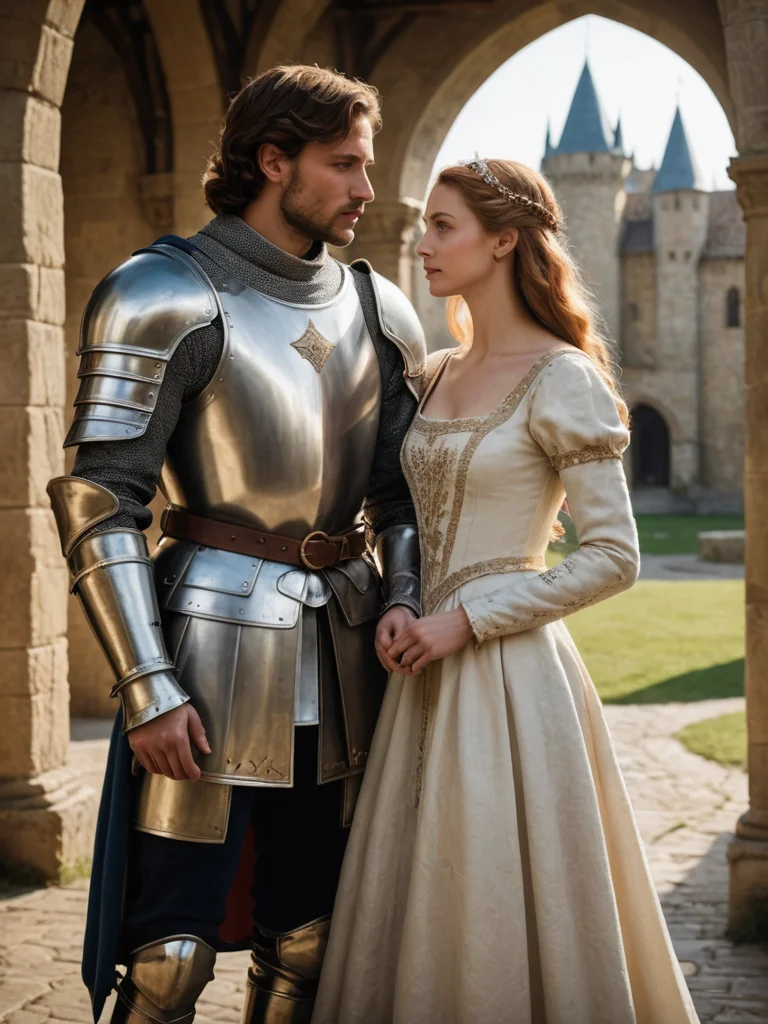The Middle Ages – an era of knights in shining armor and beautiful ladies in exquisite dresses – leaves an indelible mark on our culture. The fashion of that time was not just a matter of aesthetics; it reflected social status, religious beliefs, and, of course, military realities. Studying the clothing of knights and ladies allows us to delve deeper into their world, their values, and how they positioned themselves in society.
Introduction: Knights and Ladies of the Middle Ages – Fashion as a Reflection of the Era. Why is their clothing interesting to the modern reader?
The Middle Ages were a period of turbulent changes, crusades, epidemics, and the flourishing of art. The clothing of knights and ladies was not just functional or beautiful; it served as a powerful symbol that conveyed a great deal. From simple chainmail armor to luxurious velvet dresses, each element of the costume carried a specific meaning. Moreover, medieval fashion is an important historical source that helps us understand not only the tastes of the era but also social, economic, and political processes. Today, as interest in history grows and fantasy worlds inspired by the Middle Ages become increasingly popular, studying the fashion of that era takes on particular relevance. You, as a modern reader, can discover not only the beauty and elegance of medieval attire but also understand how clothing influenced people’s lives at that time.
The Evolution of Knightly Armor: From Chainmail to Full Plate. How a Warrior’s Protection Changed Over the Centuries.
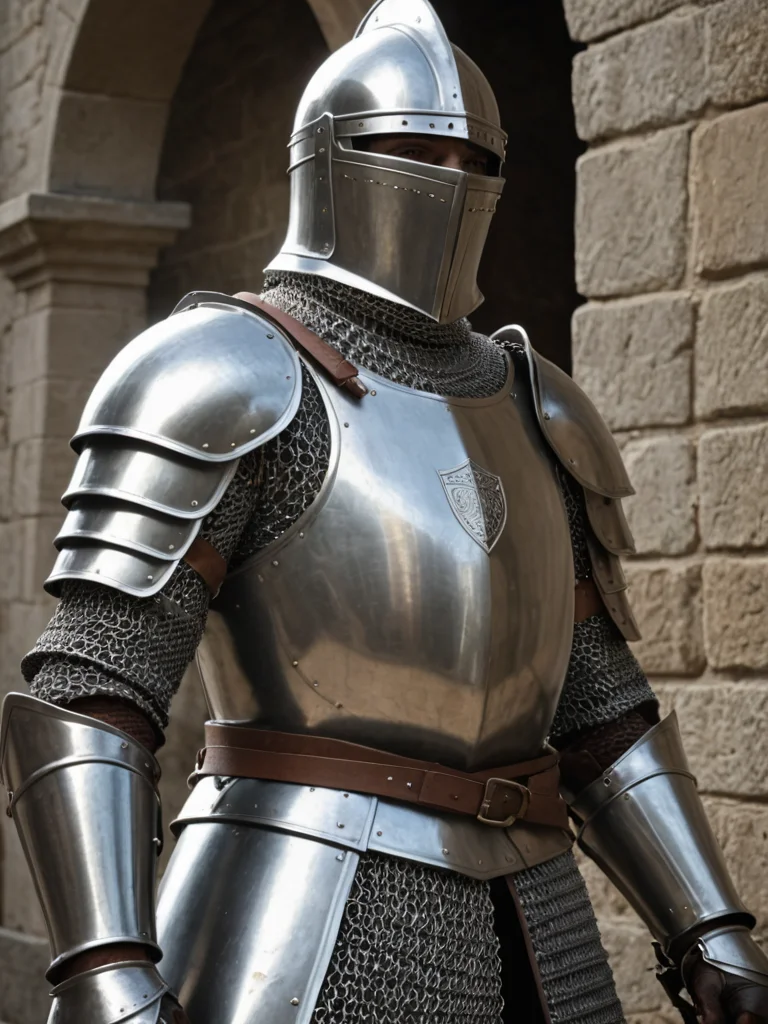
The first knights, who appeared in the early Middle Ages, were protected by relatively simple armor. Initially, these were leather jackets reinforced with metal plates. However, by the 10th century, chainmail became the primary form of protection. Chainmail is a labor-intensive and expensive item, consisting of thousands of interlinked metal rings. It provided good protection against slashing blows but was vulnerable to piercing attacks and arrows. The weight of chainmail could reach 15 kg, requiring considerable physical strength and endurance from the warrior. Over time, to enhance protection, a padded garment called a gambeson began to be worn under the chainmail. The gambeson softened blows and prevented the metal from chafing the skin.
In the 12th-13th centuries, with the development of blacksmithing, the first elements of plate armor appeared. Initially, these were metal plates covering the most vulnerable parts of the body – shoulders, knees, and elbows. Gradually, the number of plates increased, and by the 14th century, the brigandine emerged – armor consisting of many small metal plates riveted to a leather or fabric base. The brigandine was lighter and more comfortable than chainmail, provided better protection, and was cheaper to produce.
The culmination of the evolution of knightly armor was the full plate harness, which appeared in the 15th century. The plate harness consisted of many intricately joined metal plates that completely covered the warrior’s body. It provided maximum protection against any weapon, allowing the knight to feel virtually invulnerable on the battlefield. However, the plate harness was very expensive and complex to manufacture. Its weight could reach 25-30 kg, requiring the knight to have excellent physical conditioning and special training. Donning and doffing the plate harness was a whole ritual involving squires and servants. It is important to note that plate armor was not universal. Various types of plate armor existed for different purposes: tournament armor was heavier and more robust but restricted movement, while field armor was lighter and more mobile.
The helmet was an important part of knightly armor. Early helmets were simple, conical in shape, with a nasal guard for facial protection. Over time, helmets became more complex and varied. Helmets with visors appeared, which could be raised and lowered, providing better visibility and facial protection. The most common types of helmets were: the great helm (pot-shaped helmet), the bascinet (helmet with a visor), and the armet (fully enclosed helmet with a hinged visor).
The evolution of knightly armor is not just a story of technological development but also a story of changes in warfare tactics. The emergence of new types of weapons, such as the crossbow and firearms, forced blacksmiths to constantly improve armor, making it more durable and resistant to penetration. Ultimately, the development of firearms led to the decline of chivalry and the obsolescence of knightly armor.
Fashion for Ladies: Dresses, Headwear, and Jewelry. How Status and Social Position Influenced Wardrobe Choices.
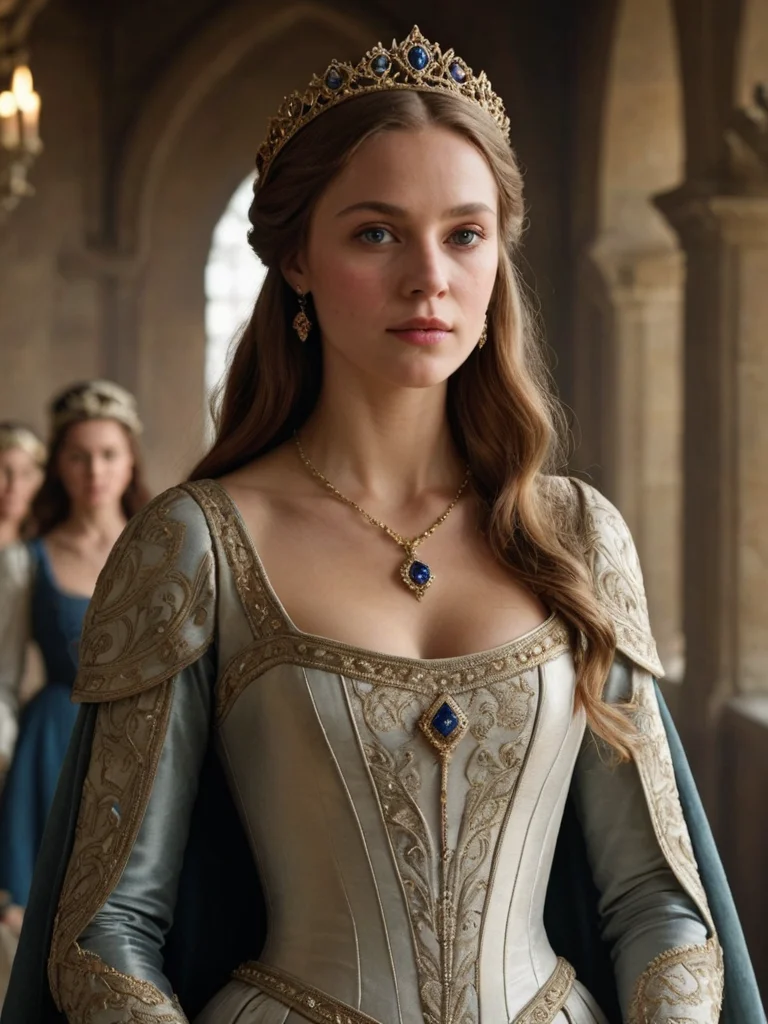
The fashion for ladies in the Middle Ages was as complex and diverse as that for knights. Women’s attire was an important indicator of social status, marital status, and personal taste. Dresses, headwear, and jewelry – all these elements played a significant role in creating the image of a medieval lady. In the early Middle Ages, women’s dresses were simple and functional. They were usually long, loose tunics made of wool or linen. The dresses were plain, without special decorations. However, with the development of trade and the growth of societal prosperity, women’s fashion became increasingly refined and luxurious.
In the 12th-13th centuries, dresses with fitted bodices and full skirts came into fashion. The bodice of the dress was often adorned with embroidery, precious stones, and pearls. The skirt of the dress could be very long, trailing on the ground. Such dresses emphasized a lady’s slender figure and high social status. A chemise was worn under the dress, as well as a corset that supported the bust and shaped the waist. An important element of women’s attire was the belt. The belt could be a simple leather cord or a luxurious piece of jewelry adorned with precious stones. The belt emphasized the waist and was used for hanging various items, such as a purse, keys, or scissors.
Headwear played an important role in medieval fashion. Women were required to cover their heads, especially in church and public places. There were many different types of headwear: coifs, veils, wimples, crowns, and diadems. The shape and decoration of the headwear depended on the social status and age of the woman. Young unmarried girls usually wore simple wreaths of flowers or ribbons, while married women wore more complex and luxurious headwear adorned with precious stones and embroidery.
Jewelry was also an important element of women’s attire. Women wore earrings, necklaces, bracelets, rings, and brooches. Jewelry was made of gold, silver, precious stones, and pearls. Jewelry with religious symbolism, such as crosses and medallions depicting saints, was particularly popular. Jewelry served not only for beauty but also as a symbol of wealth and power. The more jewelry a woman wore, the higher her social status.
Colors in clothing also had important significance. Bright and rich colors, such as red, blue, and purple, were very expensive and only affordable for wealthy and noble people. Commoners wore clothes in more modest colors – brown, gray, and green. Black was associated with mourning and sorrow in the Middle Ages, so it was worn only on special occasions. White symbolized purity and innocence, which is why it was often used for wedding dresses.
In the late Middle Ages, in the 14th-15th centuries, women’s fashion became even more extravagant and complex. Dresses with long trains, high collars, and wide sleeves appeared. Headwear of peculiar shapes came into fashion, such as hennins – tall conical hats adorned with veils and precious stones. Women began to use cosmetics to enhance their beauty. They whitened their faces and colored their lips and eyebrows. However, the church condemned the use of cosmetics, considering it a sinful practice.
Symbolism and Colors in Clothing: How Knights and Ladies Expressed Their Beliefs and Lineage Through Costume.
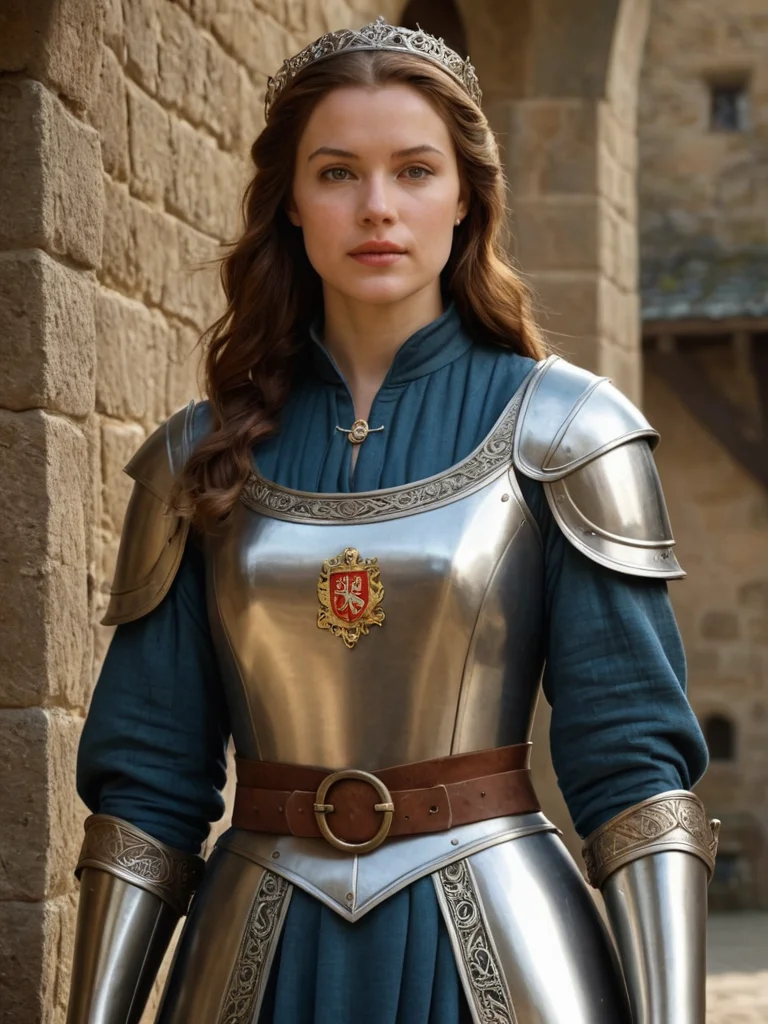
In the Middle Ages, clothing was much more than just protection from the cold or a way to adorn oneself. It served as a powerful communication tool, allowing people to express their beliefs and demonstrate their affiliation with a particular lineage or social group. Symbolism and colors played a key role in this process, imbuing each element of the costume with specific meaning.
For knights, heraldry was the basis of self-identification. The coat of arms, depicted on the shield, surcoat, and horse’s caparison, was the knight’s calling card, telling of his origin, merits, and loyalty to his liege lord. The colors of the coat of arms also had their symbolism. Gold (yellow) symbolized generosity and nobility, silver (white) – purity and innocence, red – bravery and valor, blue – loyalty and devotion, green – hope and abundance, black – wisdom and resilience. Heraldic animals, such as the lion, eagle, and griffin, also had their meanings and symbolized specific qualities that the knight wished to demonstrate.
Ladies’ clothing was also rich in symbolism. The colors of dresses, jewelry, and headwear could indicate marital status, religious beliefs, and political sympathies. For example, unmarried girls often wore white dresses, symbolizing purity and innocence, while married women wore brighter and richer colors, such as red and blue. Jewelry with religious symbolism, such as crosses and medallions depicting saints, demonstrated a lady’s piety. The shape and decoration of headwear could also indicate social status and affiliation with a particular lineage. For example, the tall conical hats – hennins, popular in the 15th century, were a symbol of high social status and wealth.
Furthermore, clothing could be used to express political beliefs. During periods of conflict and political instability, people often wore clothing of specific colors or with certain symbols to demonstrate their support for one side or another. For example, during the Wars of the Roses in England, supporters of the Lancasters wore red roses, while supporters of the Yorks wore white roses.
It is important to note that the symbolism and colors in clothing could change over time and depending on the region. What was a symbol of nobility in one place could be a symbol of mourning in another. Therefore, to correctly interpret medieval fashion, it is necessary to consider the historical context and cultural specifics.
Expressing personal beliefs and lineage through costume was an important part of medieval culture. Clothing was not just a functional item but a powerful communication tool, allowing people to declare themselves and their place in society.
Conclusion: The Influence of Medieval Fashion on Modernity. Where Can We See Echoes of Knightly Style and Ladies’ Attire Today?
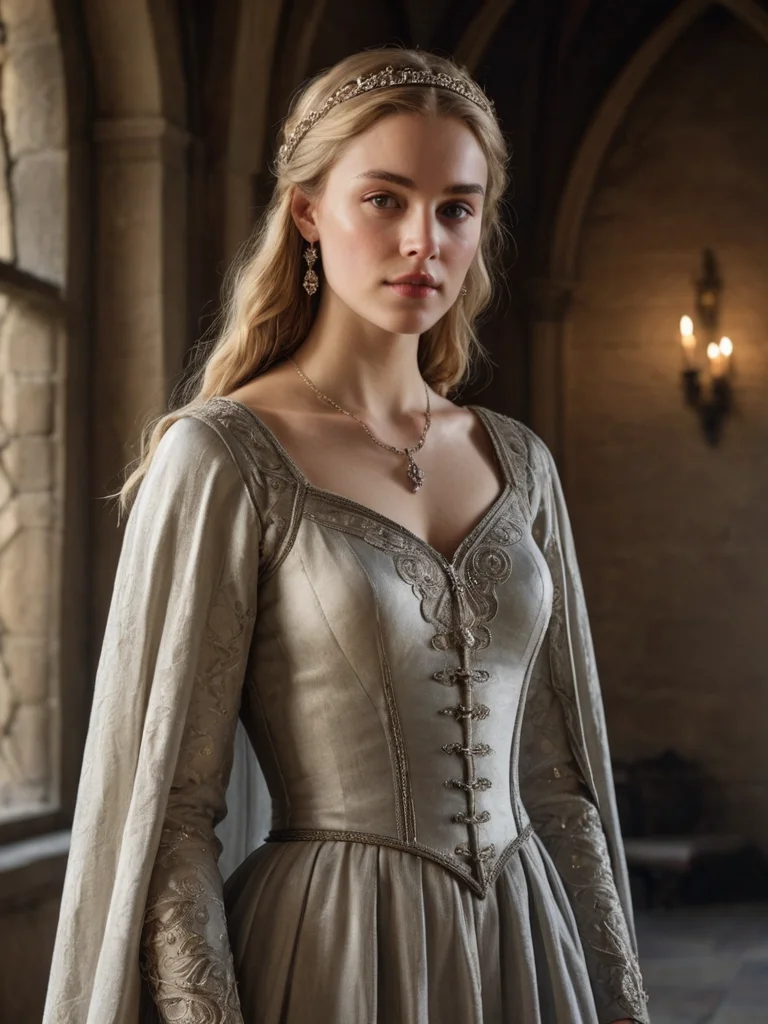
Although the Middle Ages are long behind us, their influence on modern fashion remains palpable. Echoes of knightly style and ladies’ attire can be seen in contemporary designer collections, historical films, and fantasy worlds. In particular, elements of knightly armor, such as metal plates, rivets, and leather straps, are often used in modern clothing and accessories, giving them a brutal and futuristic look. Many designers are inspired by medieval dresses with fitted bodices, full skirts, and long sleeves, creating romantic and feminine looks.
In cinema and television, medieval fashion plays an important role in creating historical authenticity and immersing the viewer in the world of the past. Costumes in historical films and series are meticulously developed to match the era and reflect the social status and character of the protagonists. Fantasy worlds, such as “Game of Thrones” and “The Lord of the Rings,” are also inspired by medieval fashion, creating unique and memorable images.
Furthermore, medieval fashion has influenced modern wedding fashion. White dresses with long trains and lace trims, popular among brides, are echoes of medieval wedding attire. Diadems and crowns adorning brides’ heads also trace back to medieval ladies’ headwear.
In everyday life, echoes of medieval fashion can be seen in elements of Gothic style, such as black dresses, corsets, lace, and metal jewelry. Additionally, many contemporary designers experiment with medieval techniques, such as embroidery, weaving, and handmade lace, creating unique and exclusive pieces.
Thus, medieval fashion has not disappeared without a trace but continues to live on in modern culture, inspiring designers, filmmakers, and people interested in history and art. Studying medieval fashion allows us not only to understand the past but also to see its reflection in the present, as well as to appreciate the beauty and elegance of the attire created in the era of knights and beautiful ladies.
